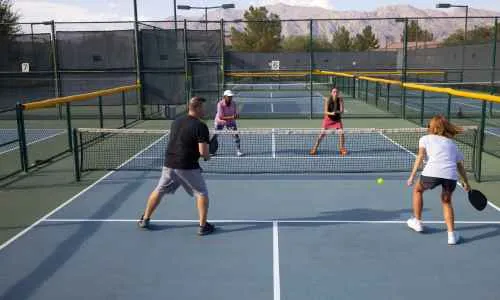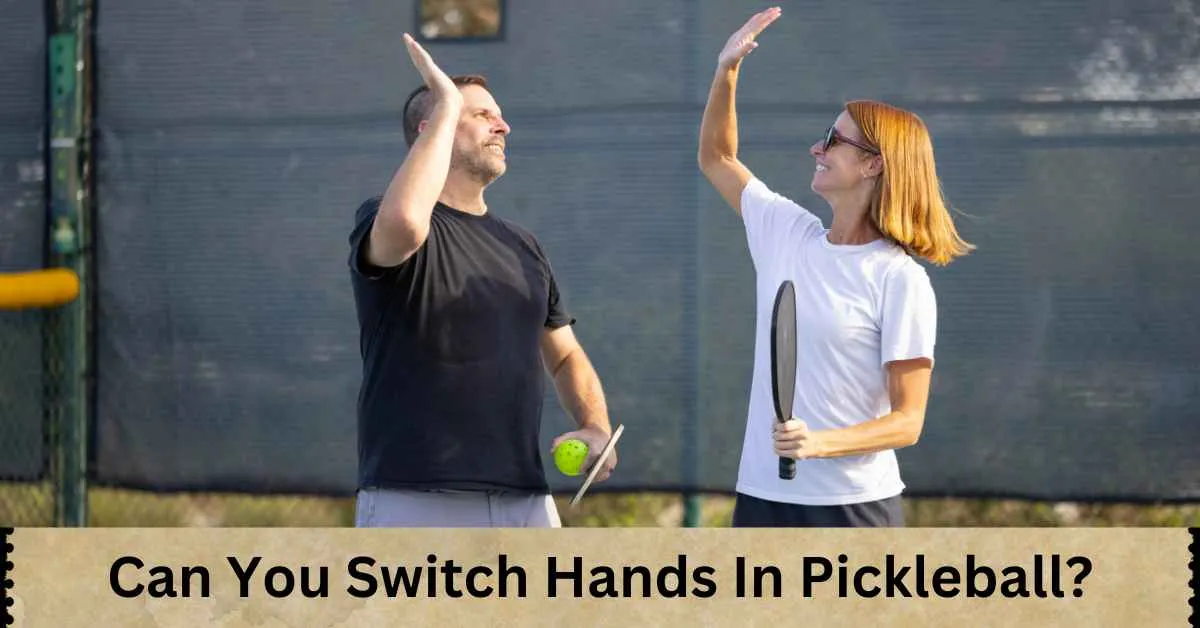Can you switch hands in pickleball? Yes, you can! Learn the advantages and disadvantages of switching hands in pickleball, as well as tips for becoming a pro at hand switching.
Switching hands in pickleball is a legal and strategic technique that can give players several advantages, such as increased reach and agility, more powerful shots, and the ability to surprise opponents. However, it is essential to practice this technique regularly to master it and avoid errors.
Pickleball is a relatively simple sport but may be challenging to master. One of the things that makes pickleball difficult is its fast-paced nature. Players frequently have limited time to react to incoming shots. Because of this, switching hands in the middle of a rally may be challenging.
Nevertheless, there are specific scenarios in pickleball where transitioning between hands can prove advantageous. This article will explore the advantages and disadvantages of changing hands during pickleball matches and when and how to execute this technique effectively.
Table of Contents
Can You Switch Hands In Pickleball?
Yes, you can switch hands in pickleball. There is no rule in the official pickleball rulebook that prohibits it. Some of the top pickleball players in the world use switching hands to their advantage.
Switching hands In pickleball can be a valuable technique for players who are prepared to practice and become proficient at it. However, it’s critical to understand the difficulties involved and to employ hand-switching tactfully.
- New Jersey 5s Advance to Premier Finals with Dominant Win
- Las Vegas Night Owls and Brooklyn Aces Advance to Challenger Title
- 5s survive against Drive in Dream Breaker
- Mastering the Pickleball Court: Footwork Drills to Elevate Your Game
- The Small-Town Kid Who Became a Pickleball Superstar! Dylan Frazier’s Inspiring Story
Should You Switch Hands in Pickleball?
Changing your dominant hand during a pickleball match can wield notable influence, yet its efficacy hinges on individual proficiency and gameplay approach. Embracing your non-dominant hand can confound adversaries and grant enhanced precision and crafty shots.
Nevertheless, honing proficiency with both hands demands diligent drills, and initially, precision and power may elude you. Lacking assurance in your non-dominant hand might lead to gameplay blunders. A strategic cadre may opt for calculated hand swaps, whereas others opt to remain loyal to their dominant hand.
Moreover, professional players like Rick Whitsken, Enrique Ruiz, Wes Gabrielson, Paradorn Srichaphan, Irina Tereschenko, Ben Johns, and Anna Leigh Waters are famous for perfectly employing this technique in big games. These players are all known for their versatile play and ability to switch hands seamlessly. Switching hands is not required for success in pickleball, but it can be a valuable technique for players trying to improve their game.

Can You Switch Hands In Pickleball?
One of the pickleball’s unique features is the flexibility to exchange hands during play. Numerous discussions took place between players and spectators regarding this extraordinary technique. Can you switch hands in pickleball? The answer is yes!
Switching hands in pickleball is a unique technique that can give players a significant advantage. It allows them to add variety and surprise to their game, improve their reach and agility on both sides of the court, and defend against tricky shots from opponents.
However, switching hands is challenging. It requires considerable coordination and practice to develop proficiency in using both your dominant and non-dominant hands. Additionally, some players may need help maintaining consistency when constantly switching between hands.
Knowing when to switch hands is crucial in pickleball. Typically, players switch when they need extra control or power for a specific shot or find themselves out of position on the court. Experimentation and experience will help determine the appropriate moments for hand-switching during gameplay. Switching hands in pickleball can be an effective strategy if executed properly.
Is it legal to switch hands in pickleball?
Yes, it is legal to switch hands in pickleball. There is no rule in the official pickleball rulebook that prohibits it. Some of the top pickleball players in the world use switching hands to their advantage.
Switching hands in pickleball can introduce an element of surprise and versatility to your game, catching opponents off guard and potentially leading to successful shots. Moreover, it can enhance your court coverage and agility on both sides, which is invaluable when defending against tricky shots.
Incorporating hand-switching into your pickleball strategy can be advantageous, provided you will try refining this skill. It’s essential to be mindful of its challenges and deploy it strategically to maximize its benefits while minimizing potential drawbacks.

Advantages of Switching Hands
Following are the Advantages of Switching Hands in Pickleball
- Enhanced Court Versatility: Switching between dominant and non-dominant hands allows adaptability and effective responses to various in-game scenarios.
- Reduced risk of injury: Switching hands can help to reduce the risk of injury by avoiding the overuse of one hand.
- Strategic Advantage: Surprise your opponents and disrupt their rhythm, gaining an edge in the match with strategic hand-switching tactics.
- Improved Coordination and Ambidexterity: Regular use of both hands during gameplay enhances motor skills, balance, and overall coordination.
- Extended Court Reach: Utilizing both hands increases your court coverage, making it easier to handle challenging shots and reach difficult-to-retrieve balls.
- Stylish Mastery: Mastering hand-switching adds finesse and flair to your pickleball game, showcasing skilful control over the paddle and a higher level of mastery.
Embrace the art of switching hands in pickleball and experience these clear advantages, from versatility and strategy to improved coordination and court coverage, all while adding a touch of finesse to your gameplay. Give it a try and experiment with mid-game paddle grip changes!
Disadvantages of Switching Hands
- Loss of Stability: One major disadvantage of switching hands in pickleball is the potential loss of stability. Changing your dominant hand may make it more challenging to maintain balance and control over your shots. This can lead to consistency in your gameplay and make it easier to execute precise shots.
- Decreased Power: Another drawback is the potential decrease in power when using your non-dominant hand. Your dominant hand has likely developed more strength and coordination, translating into more power behind your shots. When you switch hands, you may find that your shots lack the same force and speed as before.
- Reduced Accuracy: Switching hands can also affect your accuracy on the court. Your non-dominant hand may have a different finesse or muscle memory level than your dominant hand, making it harder to hit shots with precision and accuracy.
- Impact on Strategy: Switching hands can disrupt your overall strategy during gameplay. You must adapt quickly to using different grips or adjusting shot selection based on which side of the court you’re on at any given moment.
While there are definite disadvantages associated with switching hands in pickleball, some players may still choose this technique depending on their circumstances or specific court goals.
When Should You Switch Hands?
When to Switch Hands in Pickleball
- Fatigue or Injury Relief: Consider switching hands when your dominant hand is fatigued or injured to reduce strain and maintain performance.
- Adapting to Unexpected Shots: Switch hands when facing unexpected or awkward shots that your dominant hand may struggle to reach, allowing for more precise play.
- Defensive Plays: Utilize your non-dominant hand during defensive plays, especially when dealing with powerful shots directed at your backhand side, to gain better control and effectiveness.
- Avoid Excessive Switching: Be cautious not to switch hands too frequently or unnecessarily, as it can disrupt your rhythm and consistency on the court.
- Practice and Adaptability: Experiment with different strategies during practice to determine the most effective approach for your playing style, keeping in mind that proficiency with both hands takes time and practice.
Here are some specific examples of when you might want to switch hands:
- When your opponent hits a deep shot to your backhand side in singles, switch hands for a powerful forehand return.
- In doubles, if your partner is at the back of the court, switch hands for a backhand volley to the other side.
- If you’re experiencing pain in your dominant hand, switch hands to continue playing comfortably.
- To surprise your opponent, switch hands and hit a different shot than expected.
Considerations for Deciding When to Switch Hands:
- Evaluate your position on the court and your opponent’s positioning.
- Think about the required shot type for the situation.
- Take into account your own strengths and weaknesses.
- In doubles, communicate with your partner to coordinate your intentions effectively.
Developing a better understanding of when to switch hands through practice will enhance your versatility and effectiveness as a pickleball player.
Tips to Become a Pro at Hand Switching
Switching hands in pickleball can be a game-changer to surprise your opponents and keep an advantage on the court. Here are some tips to help you become a pro at hand switching in pickleball:
- Practice regularly: Like any skill, hand switching requires practice. Set aside dedicated time to work on switching hands during drills and gameplay.
- Start with simple shots: Practice hand switches on easy shots like dinks or volleys. This will help you get comfortable with the technique before moving on to more challenging shots.
- Focus on footwork: Good footwork is essential when switching hands in pickleball. Ensure you position yourself correctly for each shot, allowing enough time for a smooth transition between hands.
- Develop ambidexterity: Use specific exercises and drills to develop equal strength and control in both your dominant and non-dominant hands.
- Use video analysis: Record yourself playing and analyze your technique when switching hands. Look for areas where improvement is needed and make adjustments accordingly.
- Play with different opponents: Playing against other opponents will expose you to various playing styles, forcing you to adapt quickly by utilizing hand switches effectively.
- Remember that becoming proficient at hand-switching takes time and patience. Don’t be discouraged if it doesn’t come naturally immediately – keep practising!
By incorporating these tips into your training routine, you’ll be well-equipped to become a pro at hand switching in no time! So grab your paddle, hit the court, and start working towards improving this valuable skill.
Conclusion
Switching hands in pickleball can be a valuable technique in your arsenal. While it is legal and can provide certain advantages, disadvantages exist. Whether or not to switch hands ultimately depends on your skill level, comfort, and strategic objectives.
Remember that switching hands should be used strategically rather than constantly. Assess the situation on the court before making a decision – if it will give you an advantage or catch your opponent off guard, go for it! However, avoid unnecessary risks that could compromise your performance.

